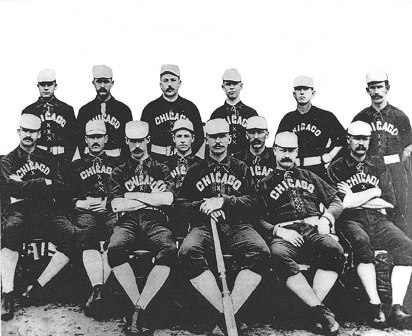Sargent Perry “Sadie” Houck played for seven National League and American Association clubs from 1879 to 1887. After his retirement, the Washington D.C. native owned a roadhouse on Conduit Road (renamed MacArthur Boulevard after World War II in honor of General Douglas MacArthur), and was occasionally sought out by local reporters for his views on the modern game.

In 1907, The Washington Evening Star said of Houck:
“(N)ext to Charley (Pop) Snyder and Doug Allison, none is remembered more by the old boys.”
And his name, “always brings the smile of fond remembrance” from fans and he was “a player that ranked with George Wright and Davy Force.”
The paper said that Houck and Snyder had played amateur ball for “the Creighton club,” which played their games on the White Lot—current site of The Ellipse, south of the White House and north of the National Mall.
The Evening Star said Houck was:
“A ‘dirty ball player,’ and by this we do not mean that he tried to injure another player, for he was never known to do an act that ever brought discredit on his fame as a straight player. But in the history of the game, no one, not even Uncle Nick Young, can recall the time when he ever saw Houck in a neat, trim condition as far as his uniform went, for he always had the appearance of a football player after a gridiron struggle on a wet and soggy field.”
Houck, who still took “a lively interest in the game,” had a strong opinion about bunting:
“Say, it gives me a pain to read about players laying down a neat bunt or playing for a sacrifice in order to advance a runner a base. Any old player who gets long green for playing base ball ought to be able to bunt or sacrifice or hie away to the tall timbers in disgust.”
Houck said:
“It is dead easy to poke your bat out in front of a pitched ball and let it hit your bat, and the fellow that is unable to do that ought to go out and chop stones.”
It was a better game he said, before “bunting was discovered by Mike Kelly.”
Houck much preferred the “science” of the “old fair foul hits,” he said:
“(They) struck on fair ground, but glanced off into foul grounds ere it reached either first or third base, and to successfully hit the ball this way required all the skill and grace of a skillful billiardist getting in his best carom work. It was impossible to hit the ball similar to the way the present-day bunters and doing, slow and methodical, but on the contrary it had to be met at a certain angle with a heavy swing in order to get the best results, and hence when success was accomplished the batsman invariably made a two-base hit.”
Houck said the best practitioners of the “clever piece of batting,” were:
“Davy Force, Ross Barnes, Joe Gerhardt, Buck Ewing, Levi Meyerle, myself,”

Ross Barnes
The tactic was so successful he said, that “pitchers of the country united and forced the new rule.”
Houck’s conclusion on how the rule change impacted the game:
“That was base ball playing with more science than these modern gladiators show in their ‘baby bunting’ plays, and I would cut out all such business. Make the players lace them out and the game will get back to the fine batting matinees that used to take place in the good old days.”
And the “modern” game:
“Nowadays the pitcher can pitch, but can’t hit; the catcher can catch, but can’t throw; the fielders can bat, but are too loggy to run, and so on through the entire crowd. Do away with your bunting a sacrificing squads and give us good old-time free batting and running.”
Houck remained in Washington D.C. for the rest of his life; by the time he died in 1919, he was so forgotten that local death notices didn’t mention he had been a major league player.

